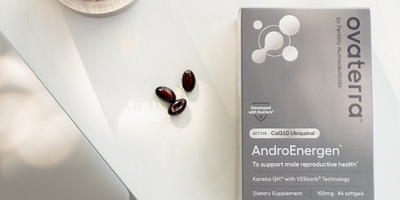Checking your cervical mucus is one way to identify when you are fertile and most likely to conceive. It's an effective way to increase your chance of pregnancy: Studies have shown that a majority of couples who track cervical mucus can get pregnant within 3-7 months. If you want to become pregnant, let’s help you better understand how to track your cervical mucus during your menstrual cycles - and why it’s important.
What is cervical mucus?
Your cervix, the canal between the uterus and vagina, produces cervical mucus when estrogen levels rise. The composition of your cervical mucus changes depending on where you are in your cycle.
You may notice that cervical mucus color, texture, and volume changes throughout your menstrual cycle. When your estrogen levels peak before and during ovulation, your cervical mucus may look like raw egg whites. That’s a strong indication that you are in your most fertile window.
Cervical mucus plays a vital role in the reproductive process. It helps the sperm move through the female reproductive system and reach the egg. Your cervical mucus changes on your fertile days to support this process, becoming more slippery, allowing sperm to swim freely.
What is cervical mucus made of?
Cervical mucus, or cervical fluid, is a mixture of insoluble gel and other soluble components, like lipids, fatty acids, trace minerals, proteins, enzyme inhibitors, and immunoglobulins.
Scientists have found that the "gel" part of the cervical mucus changes its structure from a fine filament-like structure to honeycomb-like structure, depending on the cycle phase you are in, and think that this structural change is part of what facilitates or inhibits sperm's movement within the female reproductive system.
What can cause cervical mucus to change?
The cervical mucus will change as your hormone levels rise and fall throughout your menstrual cycle. We will go more in depth later, but here are a few reasons for a change in your cervical mucus:
- Pregnancy
- Using lubricants
- Breastfeeding
- Douching
- Sexually transmitted diseases
- Bacteria or yeast infections
- Medications like birth control
- Diet and stress
Because cervical mucus changes with your reproductive hormones, you can use the changes in your cervical mucus to find the hormonal changes that also drive your fertile window.
What is the cervical mucus method of natural family planning?
The cervical mucus method, or the Billings ovulation method, can pinpoint when you are most likely to conceive. It's a low-cost and surprisingly effective method once you learn the ropes, but there are some drawbacks.
Benefits:
- Low (no) cost
- Non-invasive with no side effects
- Can be effective
- Can give you 4-5 days of fertile window
Drawbacks:
- Can be a little messy
- Can be time-consuming
- Outside factors can affect your observations
- It can take a few menstrual cycles to perfect this method
You can use this ovulation tracking method together with other fertility awareness methods, such as basal body temperature and ovulation test kits, to get a more precise understanding of your cycle, too.
When should you have sex with the cervical mucus method to get pregnant?
Checking your cervical mucus stages starts with getting to know your menstrual cycle. It is always a good idea to keep track of the number of days in your cycle and whether they are consistent or not.
When using the cervical mucus method, the best time to have sex is when your mucus turns clear and slippery, like raw egg white.
During your fertile window, sperm can travel better through clear, slippery mucus, making it easier to fertilize the egg. Sperm can live up to five days in the reproductive system, waiting to find the egg to fertilize. So, you can have sex up to 5 days before ovulation and have a chance of pregnancy.
Waiting until after ovulation to have sex only leaves you with a 12 to 24-hour window. Your best chance of conception is when you have sex a few days to just before ovulation.
After the egg is released, cervical mucus becomes cloudy and sticky, making it more difficult for sperm to travel through.
Here is a chart of what you may observe during one cycle, and what to do then.

There are other signs that you may be fertile:
- Increase in sex drive
- Breast tenderness
- Slight cramping
- Positive result from an ovulation predictor test
- Light spotting
- Slight drop in basal body temperature
Tracking these symptoms along with your cervical mucus can give you better chances of becoming pregnant.
How do I check my cervical mucus?
Checking your mucus can get a tad messy, but it's a good way to conceive using a natural family planning method. Here are a few ways to check your cervical mucus:
- Check your panties: When you use the restroom, pay attention to how your vulva feels and check to see if you have any vaginal discharge. If you do, note its color and texture. In your chart or journal, write if it is dry, watery, sticky, clear, or cloudy.
- Use your fingers: Wash your hands before inserting one finger into your vagina. Pull your finger out to observe what you see. Write or chart your observations.
- Wipe with toilet paper: Wipe with toilet paper before urinating so that the cervical mucus does not “wash” away. You can check for color, texture, and volume. It may be a little more challenging to use the toilet paper method because it is white. With a toilet paper, it can be hard to see if the mucus is clear, rather than cloudy.
Another option: try kegg
kegg is a next-generation cervical mucus tracker with a more advanced way of checking cervical mucus. kegg uses electric impedance to measure the composition of your cervical mucus, and an algorithm analyzes your results for you to take action. An easy-to-use app interprets and charts your data.
The reading will be complete in just two minutes, and you can check your result in the app. Just pick the same two-hour window to check daily. You can even record other information like your basal body temperature and sexual activity within the app.
It's one of the four modern ovulation trackers/fertility monitors that Ovaterra's scientific team recommends, based on independent testing and analyses - and comes with a 12-month pregnancy guarantee.
When should I check my cervical mucus?
You should start tracking your cervical mucus the day after your period ends. In addition, you should continue checking your cervical mucus daily to have a better sense of when ovulation will happen.
If you get your period again, you will take a break from tracking until your period ends. You may need to do this for a few cycles before you nail down this method.
It usually doesn't matter what time of day you check, but doing it roughly around the same time every day is a good idea, since - as we've looked at above - some activities can affect your cervical method.
What changes our cervical mucus?
Aside from the cyclical changes that signal your fertility status, several hormonal events can alter your cervical mucus.
Pregnancy
In early pregnancy, you may notice that your mucus is sticky, white, or yellow. You may also feel more “wet” than usual.
As pregnancy progresses, several of your reproductive hormones rise and cause an increase in vaginal discharge. This increase actually protects you and the baby from infection.
Birth control
Some birth control methods can cause side effects that can affect your cervical mucus. For example, when you start taking birth control pills for the first time, it can cause an increase in the amount of cervical mucus.
- Pills: When using birth control with estrogen and progesterone, the hormones work to prevent ovulation from happening. The hormones also cause the mucus to become thick, preventing the sperm from moving through the mucus to fertilize the egg.
- Copper IUD: This form of birth control sits inside the uterus to help prevent pregnancy. Copper is used to create a toxic uterine environment to sperm, preventing sperm from swimming through the vagina. Some scientists think that copper ion also makes cervical mucus hostile to sperm.
Cycle-related hormone changes
Variations in color, texture, and volume in your cervical mucus throughout your menstrual cycle due to hormonal changes are completely natural. As estrogen levels rise when you approach ovulation, the mucus will be clear, like an egg white.
After ovulation, progesterone levels begin to rise, which will help a fertilized egg with implantation. However, if the egg was not fertilized, the mucus will be dry.
Abnormal changes in cervical mucus
When checking your cervical mucus to track fertility, be aware if you notice some of these changes in secretions. You may want to speak to your health care provider if the following changes occur.
- Yellow, green, or gray: If you notice your cervical mucus is not clear or white, it may be a sign of infection.
- Foul odor: Healthy cervical mucus doesn’t have an odor, so if you notice a change in smell, you may have an infection.
- Burning, itching, or swelling: Although during non-fertile days, you may feel a slight itch due to dryness, it shouldn’t amount to excessive discomfort.
- Clumps: If you notice your discharge is clumpy, along with any other abnormal mucus, you may have a vaginal infection.
Picking up quickly on infections and other vaginal microbiome issues is one of the side benefits of tracking your fertile window through cervical mucus. Talk to your doctor if you notice any of these conditions.
The bottom line
Tracking your cervical mucus is a tried-and-true way to detect your most fertile days without invasive tests or recurring costs. Although it is not a reliable way to avoid pregnancy, it's quite effective for women who are trying to conceive, whether used alone or combined with other fertility awareness methods.
Please reach out if we can answer any questions about cervical mucus method and your reproductive health. We are with you.













